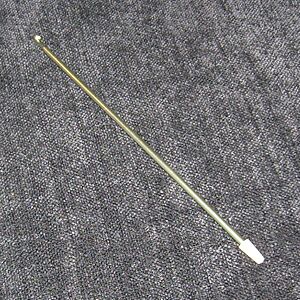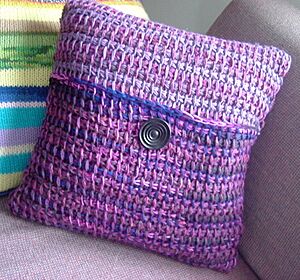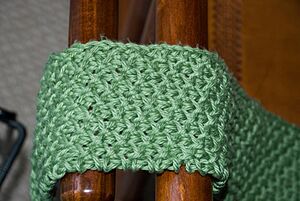Tunisian crochet facts for kids
Tunisian crochet, also known as Afghan crochet, is a unique craft that combines elements of both crochet and knitting. It uses a special, longer hook, often with a stopper at one end, called an Afghan hook. This method creates a fabric that looks different from regular crochet or knitting.
Contents
How Tunisian Crochet Works
Learning Tunisian crochet is like learning a new way to "draw" with yarn! It involves two main steps for each row, making it a bit different from other crafts.
The Forward Pass: Picking Up Loops
You start with a basic chain of stitches, just like in regular crochet. Then, for the first part of a row, you insert your special hook into each stitch. You pull a loop of yarn through, but here's the trick: you keep all these new loops on your hook! If you're right-handed, you work from right to left. By the end of this step, your hook will be full of loops, almost like casting on in knitting.
The Return Pass: Working Off Loops
Once all your loops are on the hook, you begin the second part of the row. This is called the return pass. You work from left to right, pulling a new loop of yarn through the loops already on your hook, one by one. This takes the loops off the hook. These two steps—picking up loops and then working them off—complete one full row of Tunisian crochet. Usually, you don't turn your work, which means you always work on the same side.
Working in a Circle
You can also make seamless items, like hats or tubes, using Tunisian crochet. For this, you might use a special double-ended hook. You would also use two balls of yarn. One hook and yarn add loops, and the second hook and yarn work them off. If your double-ended hook has a flexible cable, you might only need one ball of yarn.
Different Stitches and Textures
There are many different stitches you can create in Tunisian crochet. How you insert your hook and hold the yarn changes the look of the fabric. Some popular stitches include variations that look like knit stitches, purl stitches, or even intricate patterns like entrelac. Each stitch gives a unique texture and design to your finished project.
What Can You Make?
The fabric made with Tunisian crochet is usually thicker and a bit less stretchy than regular crochet or knitted fabric. This makes it perfect for warm and cozy items! Think about making blankets, scarves, or winter sweaters. Because it's so thick, it might not be the best choice for very fine items like baby clothes or thin socks.
One interesting thing about Tunisian crochet fabric is that it tends to curl a little. To make it lie flat and look neat, crafters often "block" it. This means gently shaping the finished piece by wetting or steaming it. Many people find that Tunisian crochet can be a bit faster to create fabric than regular crochet, and even quicker than knitting.
The Story Behind the Name
Tunisian crochet has had many different names throughout history! Some old names include Afghan crochet, Victorian crochet, and tricot stitch, among others. The idea of knitting with hooked needles, similar to Tunisian crochet, first appeared in what is now Germany around the late 1700s. It then showed up in France in 1817. The word "Tunisian" was first linked to this craft in Sweden in 1857. In English, the term "Tunisian Crochet" was first seen in an American book in 1862.
It's a bit of a mystery why it's called "Tunisian" crochet. There isn't a clear connection to the country of Tunisia itself. Some people think it might be because similar crafts were practiced there. Others believe Tunisia was on a trade route where these special hooked needles were sold. Another idea is that the name was chosen to make the craft sound "exotic" or from a faraway land.
See Also




